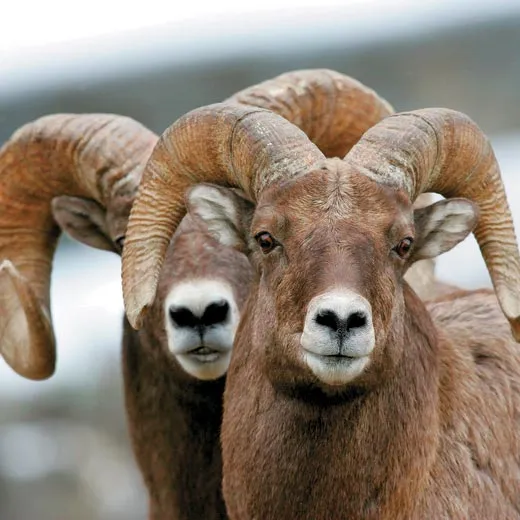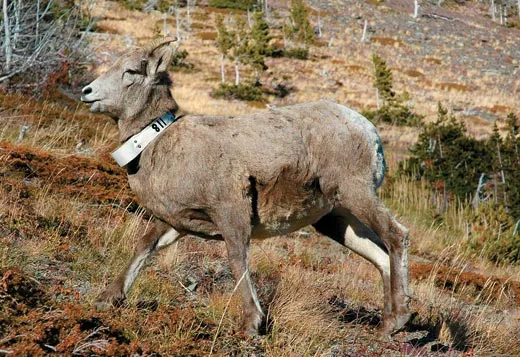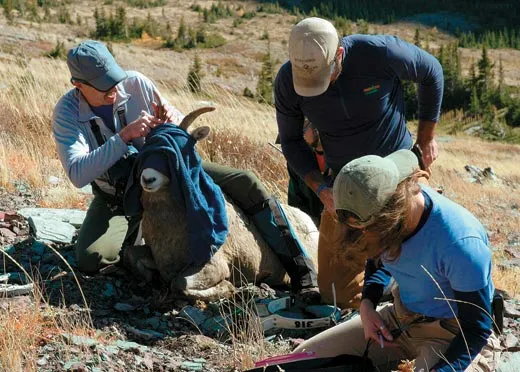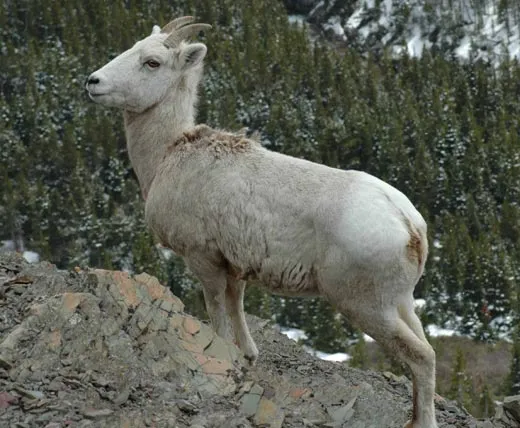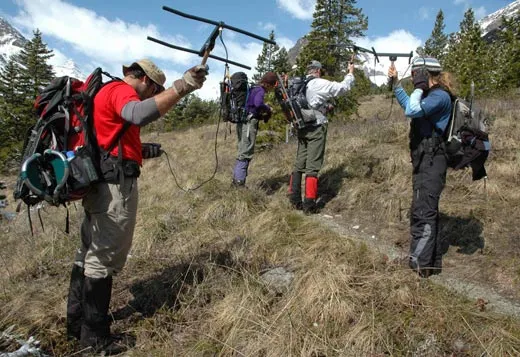Tracking the Bighorns
Where do the elusive mountain climbers go? Researchers have finally learned some answers
As the five of us hiked around Rising Wolf Mountain, a monolith of ice-chewed rock in the southeast corner of Glacier National Park, we could hear clinking and rattling somewhere in the talus slopes above us—miniature rock slides unleashed by hooves. Kim Keating, a wildlife biologist with the Northern Rocky Mountain Science Center in Bozeman, Montana, was in the lead. He has studied Glacier's bighorn sheep for two decades, collaring 99 since 2002 and tracking them with GPS recorders and radio telemetry. The tranquilizer dart he carried had enough of the narcotic carfentanil and the sedative xylazine to pacify a 300-pound sheep. Because the dose is lethal to humans, Keating—and only Keating—would handle the dart.
The low-angled autumn sun lit up yellowing larch trees like candles. Stephanie Schmitz—one of three fieldworkers assisting Keating—spotted a small herd of bighorn in a golden meadow up ahead. Keating loaded his dart rifle, then began edging toward the animals. They raised their heads. Keating stopped, pretending to be doing nothing. He sat down for a few minutes. "To avoid startling them, you want the sheep to see you," he explained later, "but you have to be willing to walk away if the shot isn't right."
The sheep dropped their heads to munch on grass. Keating crept into shooting range—20 yards away or less—aimed and fired. A few sheep ran; some stared, befuddled. A ewe staggered.
The crew's first job was to prevent the ewe from tumbling downhill. "If they get going, they'll roll to the bottom of the mountain," Keating said. Assistant Josh Brown blindfolded the groggy animal, holding her head erect by the horns. Keating collected a snip of hair, a vial of blood and a swab of saliva. He counted two growth rings on her horn: she was 2 1/2 years old. Collar number 118, affixed with a radio transmitter and a GPS recording unit, was cinched around her neck. Keating injected the ewe with a drug to bring her out of her stupor. After a few wobbly steps, she ambled off to join the herd.
Bighorn sheep, Ovis canadensis, are a majestic symbol of the mountainous West. They browse at high altitudes and in steep, rocky areas from Texas to British Columbia. Rams' horns curl around their eyes and grow up to 45 inches long. Males butt horns to establish dominance during the fall rut. Ewes sport shorter, spiked horns similar to a mountain goat's. From their first days of life, bighorns are sure-footed enough to scale cliffs too steep for most predators to follow.
Two centuries ago, an estimated 1.5 million to 2 million bighorn sheep lived in North America; today, a mere 28,000 remain. Diseases caught from domestic sheep, competition from livestock for forage, and trophy hunting for their horns caused populations to plummet. Bighorns graze in mountain meadows, habitat that is being lost to expanding forests, which are growing beyond their historic boundaries in part because the wildfires that used to hold them in check have been suppressed. Glacier National Park, home to 400 to 600 bighorn sheep, lists the animal as a "species of concern," that is, at risk of becoming endangered.
To protect bighorns, Keating says, we have to understand them better. That's his mission. Each battery-powered GPS unit records the animal's location every five hours for a year. Then, on a programmed day, the collar drops off; Keating must go find it. "Retrieving a collar with its 1,600 or more stored location points is like Christmas," Keating said. "You never know what you'll find."
In the past few years Keating's collars have recorded a great deal of new information about bighorn behavior in the park, including previously unknown wintering, rutting and lambing sites. The devices have shown that bighorns travel greater distances, up to 20 miles, and visit mineral licks more often than researchers realized. The work has also revealed just how sheep-like bighorns can be. That is, they're creatures of habit. "They seldom explore new habitat," Keating says. They travel to and from their ranges for wintering, lambing and browsing along paths used by the herd for generations.
North of Rising Wolf Mountain is one of the park's historic tourist hubs, called Many Glacier. Four valleys laced with glaciers and alpine lakes come together here. Bighorns are common in this part of the park, and wildlife biologists have studied them here since the 1920s. Nobody had ever reported sheep wintering on Mount Allen, a large buttress on the main valley's south side. Yet that's where collars tracked wintering bighorns. GPS points also debunked a long-held belief that bighorn on adjacent slopes constituted a single herd; instead, sheep stay in separate herds throughout the year. Keating laughs: more than eight decades of bighorn research in Many Glacier has been overturned by fist-size GPS units.
He and geneticist Gordon Luikart of the University of Montana are getting even more bighorn insights from DNA samples. For instance, a preliminary study suggests that two populations living only 25 miles apart—one in Many Glacier and the other in Two Medicine—have surprisingly different genes. The contrast is "approximately the difference you would observe between Asians and Europeans. So it's a very large difference for such a small distance." Keating says it's possible the herds haven't mingled much since the last ice age ended more than 10,000 years ago.
Such isolation might protect the animals. In the 1980s, an outbreak of pneumonia wiped out 65 percent of southern Alberta's bighorn sheep and infected Many Glacier's population. But the Two Medicine herd was spared.
Six months after i watched Keating and his crew collar sheep, we met again below Rising Wolf Mountain on a gusty day in May. We hiked up the purple pasqueflower-lined trail, listening to beeping radio signals picked up by three telemetry antennas. "Glacier is one of the worst places for radio tracking," Keating said, turning in a slow circle with an antenna overhead. "The mountainous terrain ricochets signals off cliffs, sending a strong beep from both the collar's location and its opposite direction." Our primary goal was to find six collars, most of which had been programmed to fall off two days earlier.
Our other task was to collect feces from ewe 118, the one we had collared in the fall. Hormone levels in fecal samples, which Keating sends to the National Zoo for analysis, indicate whether a ewe is pregnant. By combining this information with field observations of birth rate and survival rate, Keating can predict the herd's population growth. Ewe 118 was browsing on a steep hillside amid 40 sheep still in their white winter coats. Schmitz and another researcher pursued her across snow, ridges and cliffs. We wouldn't see them again for eight hours.
The rest of us followed well-worn sheep paths uphill—scrambling over rocks, slipping on pebbly scree. We were in prime bighorn territory, and collar 568 lay in plain sight on the rocks. Another collar was buried beneath early winter snows. Keating donned crampons and grabbed an ice ax to ascend a small, steep couloir, and dug it out.
As we trekked out along the muddy trail, sun glinted off Rising Wolf's snow-packed gullies. After 11 hours of hiking in Glacier's moody weather, we'd collected one ewe's scat, counted 84 bighorns and found four of six collars. Keating's pack cradled thousands more bighorn location points full of surprises.
Becky Lomax is the author of Moon Handbooks: Glacier National Park and was a hiking guide in the park for 10 years.
